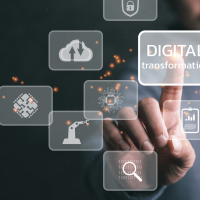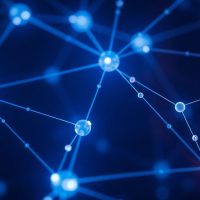Imagine a world where humans and AI don’t just work together, but truly team up. It’s not about machines taking over, or even just being tools. We’re talking about a future where humans ai combine their strengths to do amazing things. This idea, called symbiotic AI, means we build AI systems that fit right in with how people think and work. It’s a partnership where human smarts and AI’s power make something totally new and better.
Key Takeaways
- Humans and AI can work together in a deep way, like a real partnership, not just one using the other.
- This kind of teamwork can change big industries, from healthcare to how we learn things.
- When humans and AI combine, it can help people be more creative and solve problems better.
- The future of jobs probably means new kinds of work and chances for people, with AI helping out.
- We need to think about what’s right and wrong as we build these AI systems, making sure people stay in charge.
Understanding Symbiotic AI

Defining The Human-AI Partnership
Symbiotic AI is all about teamwork. It’s not about robots taking over, but about humans and AI working together to achieve more than either could alone. Think of it as a super-powered collaboration where each side brings unique skills to the table. This partnership aims to amplify human potential, not diminish it. It’s about creating systems where AI assists us, making us smarter, faster, and more effective.
Beyond Replacement: Augmenting Human Capabilities
Forget the sci-fi movies where robots replace humans. The real future lies in augmentation. AI should be designed to boost what we’re already good at. Imagine doctors using AI to analyze medical images with incredible speed and accuracy, or engineers designing structures with AI-powered simulations that reveal hidden weaknesses. It’s about making our jobs easier, more efficient, and less prone to error. This approach ensures that AI serves as a tool to enhance problem-solving abilities, not a threat to our livelihoods.
The Complementary Nature Of Intelligence
Humans and AI have different kinds of intelligence. We excel at creativity, critical thinking, and understanding complex social situations. AI shines at processing massive amounts of data, identifying patterns, and performing repetitive tasks with unwavering precision. The key to symbiotic AI is recognizing and leveraging these differences. By combining our strengths, we can create systems that are far more powerful than anything we could build alone.
Symbiotic AI isn’t just about technology; it’s about a new way of thinking. It requires us to design AI systems that are inherently collaborative, prioritizing human needs and values above all else. This means focusing on transparency, trust, and ethical considerations from the very beginning.
The Core Principles Of Symbiotic Design
Symbiotic AI isn’t just about making machines smarter; it’s about crafting a partnership where humans and AI work together, each bringing unique strengths to the table. This requires careful design, focusing on how these systems interact with and support people. Let’s explore some key ideas.
Prioritizing Human-Centric AI Development
When building symbiotic AI, the human element must come first. This means designing AI systems that are intuitive, easy to use, and tailored to the specific needs and abilities of the people who will be interacting with them. It’s not about forcing people to adapt to machines, but about creating tools that seamlessly integrate into their workflows and enhance their capabilities. Think about it: a doctor using AI to analyze medical images in healthcare shouldn’t need a computer science degree to understand the results. The AI should present information in a clear, concise way that supports their decision-making process.
Fostering Trust Through Collaborative Interfaces
Trust is essential for any successful partnership, and human-AI collaboration is no different. To build trust, AI systems need to be transparent and explainable. People need to understand how the AI is making decisions and be able to verify its accuracy. Collaborative interfaces play a crucial role here. They should provide users with the right level of information, allowing them to monitor the AI’s performance, provide feedback, and intervene when necessary. This might involve:
- Visualizing the AI’s reasoning process.
- Providing access to the data the AI is using.
- Allowing users to override the AI’s decisions.
By creating interfaces that promote transparency and control, we can empower people to trust AI systems and work with them more effectively.
Integrating Human Intuition With Machine Precision
Humans and AI excel at different things. AI is great at processing large amounts of data and identifying patterns, while humans possess intuition, common sense, and the ability to handle ambiguous situations. Symbiotic design seeks to combine these strengths, creating systems that leverage both human intuition and machine precision. This means designing AI that can learn from human feedback, adapt to changing circumstances, and provide insights that humans might otherwise miss. It’s about creating a synergistic relationship where the whole is greater than the sum of its parts. Consider how AI systems can assist physicians by analyzing medical imagery and suggesting possible diagnoses while leaving final decisions to doctors. The doctor’s feedback improves the AI’s future performance, creating a continuous improvement cycle that enhances both the AI system and the physician’s capabilities.
Revolutionizing Industries With Humans AI
Transforming Healthcare And Medical Remedies
AI is changing healthcare in big ways. It’s not about replacing doctors and nurses, but about giving them better tools. AI can analyze medical images faster and more accurately than humans, helping to diagnose diseases earlier. Think about how much faster a diagnosis could be with AI helping to sift through mountains of data. This means quicker treatment and better outcomes for patients. AI can also help personalize treatment plans, tailoring them to each person’s unique needs. It’s like having a super-smart assistant that never gets tired and always has the latest information at its fingertips. This is especially useful in areas like drug discovery, where AI can speed up the process of finding new medicines. For example, AI in U.S. mobile app development is being used to create apps that monitor patients’ health and provide personalized recommendations.
- Faster diagnosis
- Personalized treatment plans
- Accelerated drug discovery
AI is not just a tool; it’s a partner that can help healthcare professionals provide better care and improve the lives of patients around the world. It’s about combining the best of human intuition and compassion with the power of machine learning.
Advancing Education And Learning
Education is another area where AI is making a huge impact. AI can personalize learning experiences for students, adapting to their individual needs and learning styles. Imagine a classroom where every student has a personal tutor that understands their strengths and weaknesses. AI can also automate administrative tasks, freeing up teachers to focus on what they do best: teaching. This could mean less time spent grading papers and more time spent interacting with students. Plus, AI can provide students with instant feedback, helping them to learn more effectively. It’s like having a learning companion that’s always there to help you succeed.
- Personalized learning paths
- Automated administrative tasks
- Instant feedback for students
Innovating Engineering And Materials Science
AI is also revolutionizing engineering and materials science. It can help engineers design better products, optimize manufacturing processes, and discover new materials. AI algorithms can analyze vast amounts of data to identify patterns and predict outcomes, leading to more efficient and innovative designs. This is especially useful in industries like aerospace and automotive, where even small improvements can have a big impact. AI can also help engineers simulate real-world conditions, allowing them to test designs virtually before building physical prototypes. It’s like having a virtual lab that can run experiments 24/7. This can save time and money, and lead to better products that are safer and more reliable.
| Area | AI Application | Benefit |
|---|---|---|
| Design | Generative design algorithms | Optimized designs, faster iteration |
| Manufacturing | Predictive maintenance, process optimization | Reduced downtime, increased efficiency |
| Materials | Discovery of new materials | Improved performance, novel properties |
Unlocking Human Potential Through AI
AI As A Catalyst For Creativity
AI isn’t just about automating tasks; it’s also a tool that can spark human creativity. Think of it as a collaborator that can provide new ideas, analyze existing work for patterns you might have missed, and even generate initial drafts or prototypes. This allows humans to focus on the more abstract and innovative aspects of creation. It’s like having a super-powered assistant that handles the grunt work, freeing you up to explore new artistic and intellectual territories. I’ve seen artists use AI to create unique visual styles, musicians compose unconventional melodies, and writers develop plotlines they never would have considered on their own. It’s a pretty cool way to push the boundaries of what’s possible.
Enhancing Problem-Solving Abilities
Complex problems often require analyzing massive amounts of data and considering numerous variables. This is where AI really shines. It can quickly sift through information, identify trends, and generate potential solutions that humans might overlook. But the key is that AI doesn’t replace human judgment; it enhances it. We can use AI’s insights to inform our decisions, evaluate different options, and ultimately arrive at more effective solutions. It’s like having a powerful analytical tool that helps us see the bigger picture and make more informed choices. For example, in business, AI can help identify market opportunities, optimize supply chains, and predict customer behavior. In science, it can accelerate research by analyzing experimental data and suggesting new avenues of investigation. It’s a game-changer for problem-solving across many fields. The future of AI solutions is bright.
Expanding Human Cognitive Horizons
AI can also help us expand our cognitive abilities by providing access to information and insights that would otherwise be beyond our reach. Imagine having a personalized learning assistant that adapts to your individual needs and helps you master new skills. Or a research tool that can quickly summarize complex scientific papers and identify relevant information. AI can also help us overcome cognitive biases and make more objective decisions. It’s like having a cognitive enhancer that helps us think more clearly, learn more effectively, and make better choices.
AI is not just a tool for automation; it’s a partner that can help us unlock our full potential. By working together, humans and AI can achieve more than either could alone. This collaboration can lead to new discoveries, innovative solutions, and a more fulfilling future for all.
Here’s a simple breakdown of how AI can expand our cognitive horizons:
- Personalized learning experiences
- Improved access to information
- Enhanced decision-making
- Increased creativity
Navigating The Future Of Work
The integration of AI into the workplace is not just a technological shift; it’s a fundamental reshaping of how we work, what skills are needed, and the very nature of employment. This transformation presents both exciting opportunities and significant challenges that require careful consideration and proactive strategies.
Creating New Roles And Opportunities
Contrary to some fears, AI is not solely about job displacement. History suggests that technological advancements often lead to the creation of new roles and industries. Think about it: the rise of the internet spawned countless jobs that didn’t exist before. AI is likely to do the same. These new roles will likely focus on:
- AI development and maintenance: We’ll need people to build, train, and maintain AI systems.
- Data analysis and interpretation: AI generates vast amounts of data, requiring skilled analysts to extract insights.
- Human-AI collaboration management: Ensuring effective teamwork between humans and AI will be crucial.
The key is to anticipate these emerging opportunities and prepare the workforce accordingly. This means investing in education and training programs that equip individuals with the skills needed to thrive in an AI-driven economy. The future trends will shape work, and it’s up to us to be ready.
Adapting To Evolving Job Landscapes
Even if AI creates new jobs, many existing roles will change. Some tasks will be automated, requiring workers to adapt and acquire new skills. This doesn’t necessarily mean complete job loss, but rather a shift in responsibilities. For example, a customer service representative might use AI-powered tools to quickly access information and resolve customer issues, allowing them to focus on more complex and empathetic interactions. The focus shifts from routine tasks to problem-solving, critical thinking, and creativity. It’s about augmenting human capabilities, not replacing them entirely.
The Role Of AI In Workforce Development
AI itself can play a significant role in workforce development. Personalized learning platforms can use AI to identify skill gaps and recommend tailored training programs. AI-powered tools can also provide on-the-job support, offering real-time guidance and assistance to workers. This continuous learning and development will be essential for staying relevant in a rapidly changing job market. Consider these points:
- AI-driven skills assessment: Identifying individual strengths and weaknesses.
- Personalized learning paths: Tailoring training to specific needs.
- AI-powered coaching: Providing real-time support and feedback.
Ultimately, navigating the future of work requires a proactive and adaptable approach. By embracing AI as a tool for augmentation and investing in workforce development, we can ensure that humans and AI work together to create a more productive and fulfilling future.
Ethical Considerations In Human-AI Collaboration

Ensuring Responsible AI Development
As AI becomes more integrated into our lives, it’s super important to think about the ethical side of things. We need to make sure AI systems are developed and used in a way that’s fair, transparent, and accountable. This means avoiding bias in algorithms, protecting people’s privacy, and making sure AI doesn’t discriminate against certain groups. It’s a big job, but it’s essential for building trust in AI.
- Establish clear guidelines and standards for AI development.
- Promote transparency in AI algorithms and decision-making processes.
- Implement mechanisms for accountability and redress when AI systems cause harm.
Addressing Potential Societal Impacts
AI has the potential to change society in big ways, both good and bad. We need to think about these potential impacts and take steps to manage them. This includes things like job displacement, the spread of misinformation, and the potential for AI to be used for malicious purposes. It’s not always easy to predict what will happen, but we need to be proactive in addressing these challenges. For example, we can look at how AI is transforming healthcare and medical remedies.
It’s important to remember that AI is a tool, and like any tool, it can be used for good or for bad. It’s up to us to make sure it’s used in a way that benefits everyone.
Maintaining Human Agency And Moral Depth
One of the biggest ethical challenges of human-AI collaboration is making sure humans stay in control. We don’t want to become overly reliant on AI or let it make decisions that should be made by humans. It’s also important to preserve our moral values and make sure AI is aligned with our ethical principles. This means designing AI systems that respect human autonomy, promote human well-being, and uphold our shared values.
- Design AI systems that augment, rather than replace, human capabilities.
- Promote human oversight and control over AI decision-making processes.
- Incorporate ethical considerations into the design and development of AI systems.
The Path To A Harmonious Future
It’s easy to get caught up in the scary stories about AI, but there’s another way to look at it. What if we could actually work with AI to make things better? It’s not just about avoiding disaster; it’s about building something amazing together. This requires a shift in perspective, seeing AI not as a replacement, but as a partner.
Building Mutual Respect And Adaptability
Think about any good relationship – it needs respect and the ability to change. Same goes for humans and AI. We need to value what each brings to the table. Humans are good at creative problem-solving, understanding emotions, and making ethical calls. AI is great at crunching numbers, spotting patterns, and handling huge amounts of data. If we can appreciate these different strengths, we’re off to a good start.
Cultivating A Shared Vision For Progress
It’s not enough to just have AI; we need to know what we want to do with it. What problems are we trying to solve? What kind of world are we trying to build? This means having open conversations about our goals and values. It also means making sure everyone has a seat at the table – not just tech experts, but also ethicists, policymakers, and everyday people. A shared vision helps us steer AI in a direction that benefits everyone.
Achieving Collective Intelligence For Global Challenges
Imagine a world where humans and AI work together to tackle the big problems: climate change, disease, poverty. It sounds like science fiction, but it’s within reach. By combining human insight with AI’s analytical power, we can come up with solutions that would be impossible otherwise. This "collective intelligence" could revolutionize how we approach global challenges.
Here are some areas where this could make a huge difference:
- Environmental Sustainability: AI can analyze climate data to help us develop better strategies for reducing emissions and protecting ecosystems.
- Healthcare: AI can help doctors diagnose diseases earlier and develop personalized treatments.
- Education: AI can create customized learning experiences for students, helping them reach their full potential.
The key is to focus on collaboration, not competition. We need to create systems where humans and AI learn from each other, adapt to each other’s strengths and weaknesses, and work together towards a common goal. This is how we unlock the true potential of symbiotic AI and create a future where everyone benefits.
The Path Ahead: Working Together
So, as we wrap things up, it’s pretty clear that the whole human-AI thing isn’t about one taking over the other. It’s more like, how can we team up? Think about it: humans bring the big ideas, the feelings, and that spark of creativity. AI, on the other hand, is super good at crunching numbers and finding patterns really fast. When these two come together, it’s like a whole new level of problem-solving. We’re talking about a future where AI helps us do things we never thought possible, making our lives better in ways we’re just starting to imagine. It’s a partnership, really, and it’s going to change everything.
Frequently Asked Questions
What exactly is “Symbiotic AI”?
Symbiotic AI means humans and AI working together, like a team. Instead of AI doing everything by itself, it helps people do their jobs better and smarter. It’s about combining human creativity and smarts with AI’s speed and ability to handle lots of information.
Will Symbiotic AI take away people’s jobs?
It’s not about robots taking over jobs. Instead, it’s about AI helping us in new ways. Think of it like a super-smart assistant that makes us more capable, not less. This can lead to new kinds of jobs that we can’t even imagine yet.
How can we make sure Symbiotic AI is safe and fair?
We need to make sure AI is built fairly and used responsibly. This means thinking about what’s right and wrong, and making sure humans are always in charge of important decisions. It’s like having good rules for a new game.
How will Symbiotic AI change our daily lives?
It can change many things! In healthcare, AI could help doctors find cures faster. In schools, it could make learning more fun and personal. In building things, AI could help engineers design amazing new materials and structures.
How can humans and AI work together to solve big problems?
By working together, humans and AI can solve really big problems, like climate change or finding new medicines. Humans bring fresh ideas and understanding, while AI can process huge amounts of data to find solutions. It’s like having a super-powered brain.
What does the future look like with Symbiotic AI?
It means we’ll see AI helping people in almost every job. It won’t be about AI replacing us, but about AI making us better at what we do. This will create a future where human skills and AI power combine to achieve amazing things.

Peyman Khosravani is a seasoned expert in blockchain, digital transformation, and emerging technologies, with a strong focus on innovation in finance, business, and marketing. With a robust background in blockchain and decentralized finance (DeFi), Peyman has successfully guided global organizations in refining digital strategies and optimizing data-driven decision-making. His work emphasizes leveraging technology for societal impact, focusing on fairness, justice, and transparency. A passionate advocate for the transformative power of digital tools, Peyman’s expertise spans across helping startups and established businesses navigate digital landscapes, drive growth, and stay ahead of industry trends. His insights into analytics and communication empower companies to effectively connect with customers and harness data to fuel their success in an ever-evolving digital world.










